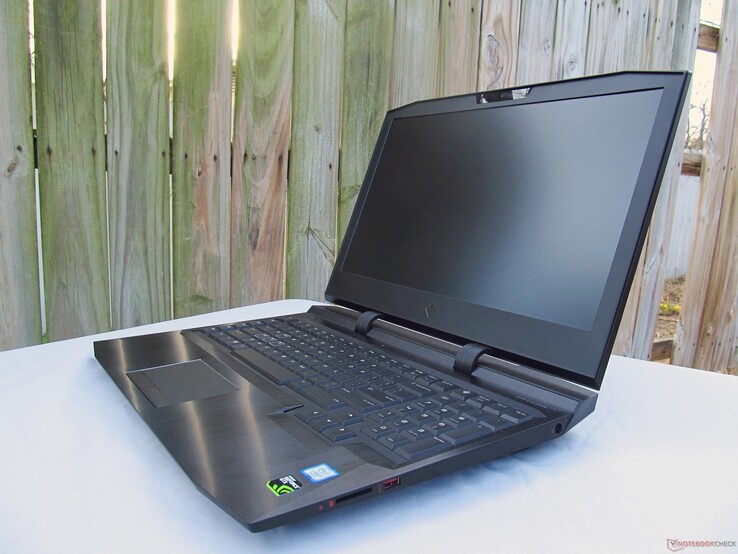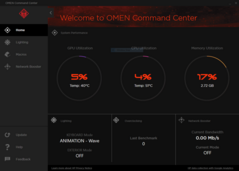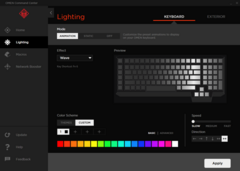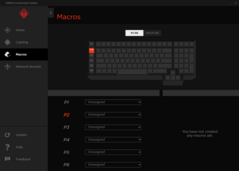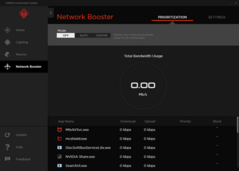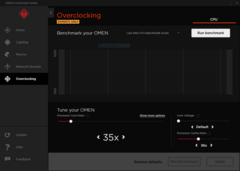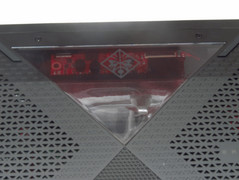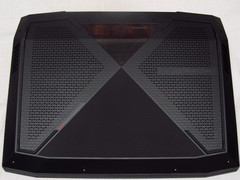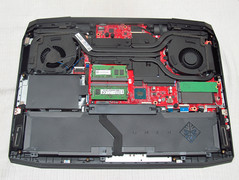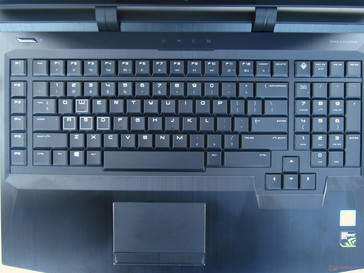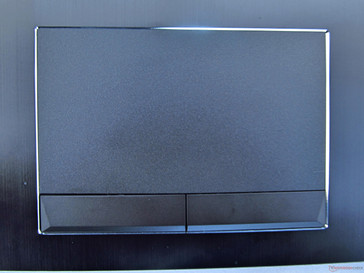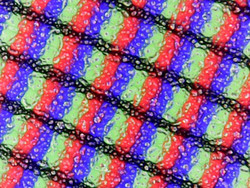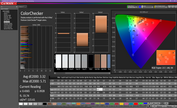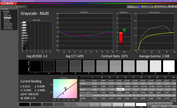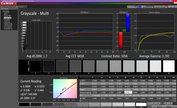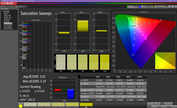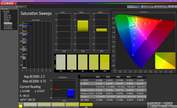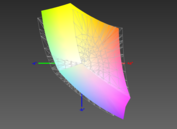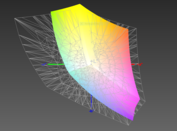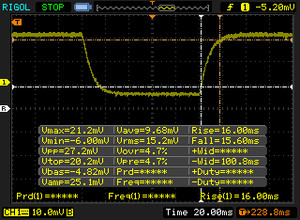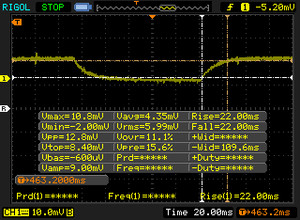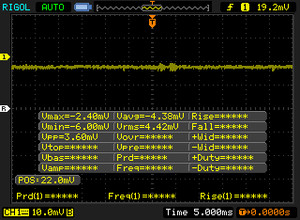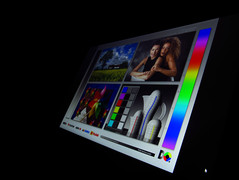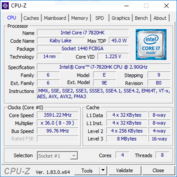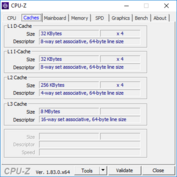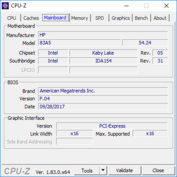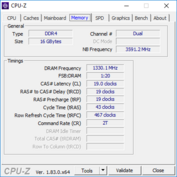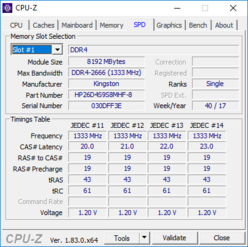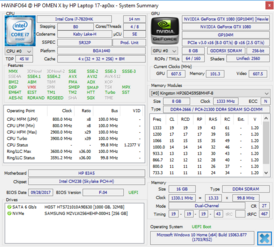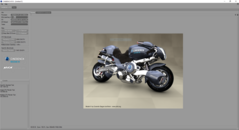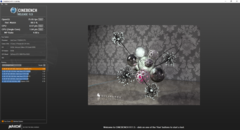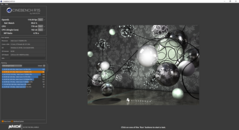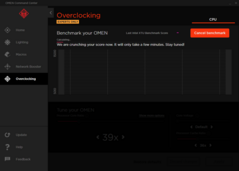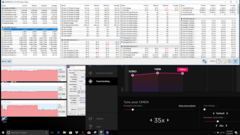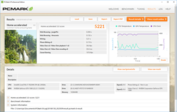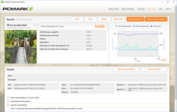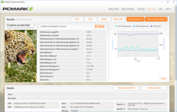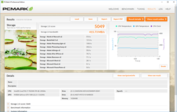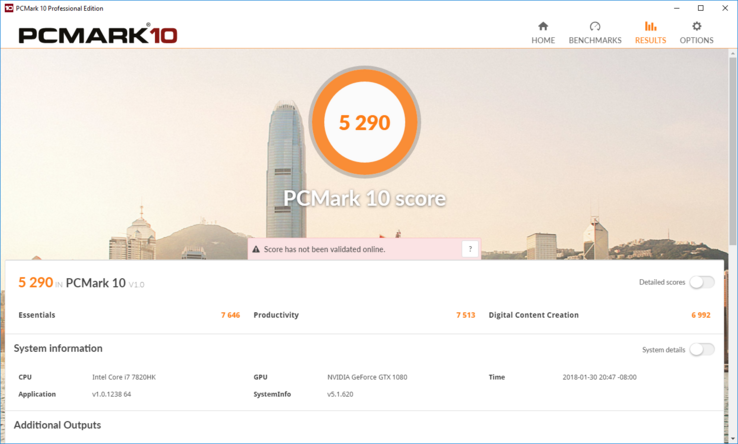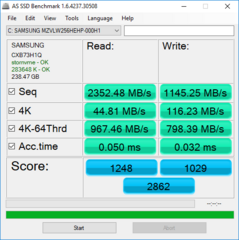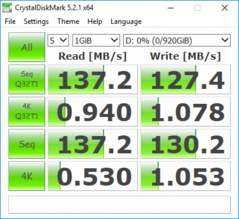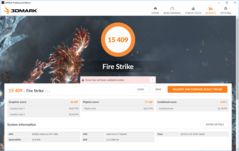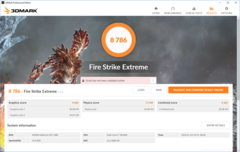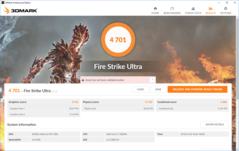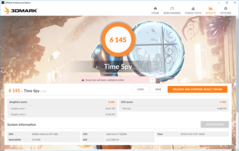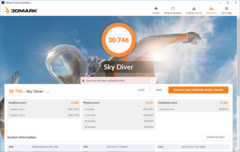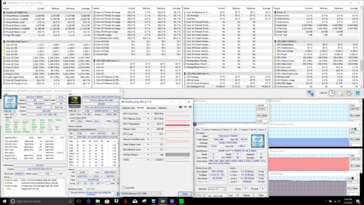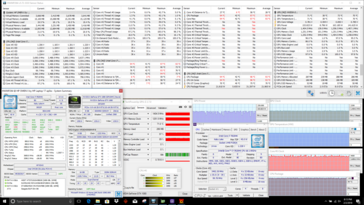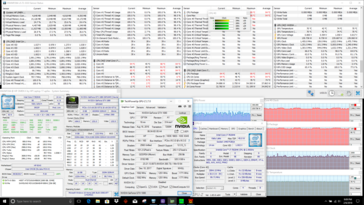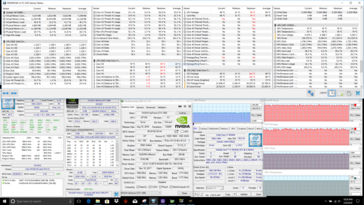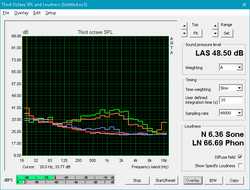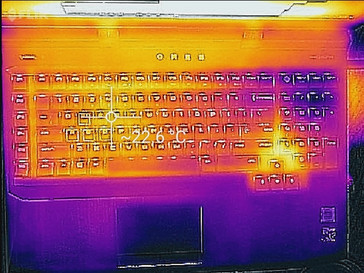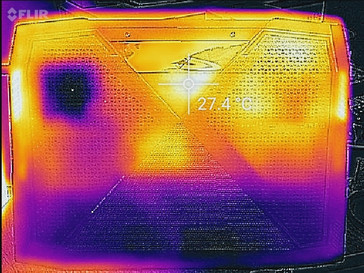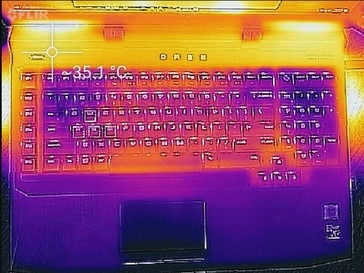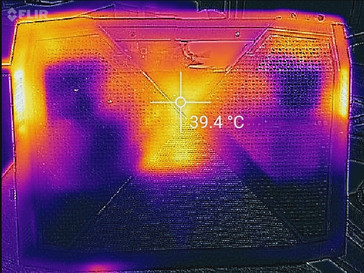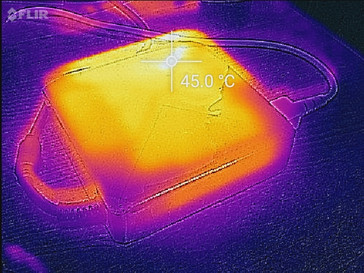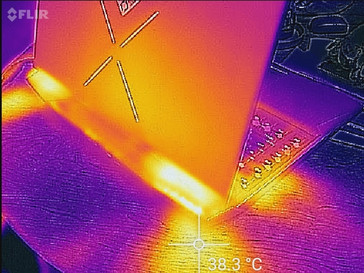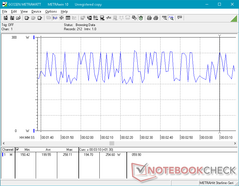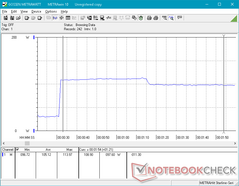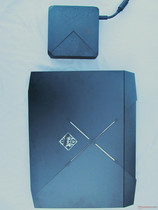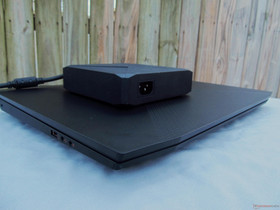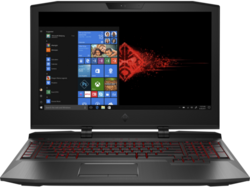HP Omen X 17 (7820HK, GTX 1080, 120 Hz FHD) Laptop Review

Over the past two years, HP's Omen series has moved from an interesting experiment to a serious contender in the premium gaming laptop market. It's interesting that a company traditionally known for business-centric notebook and desktop computers has been pushing so heavily to capture some market share amongst gamers, but their recent offerings have been good contenders for consumers' wallets. However, in light of the increase of gaming laptop sales, it only makes sense for HP to put a heavier emphasis on this end of the market.
Today, we have the HP Omen X 17. Our model represents the most powerful configuration currently available from HP. Packing an overclockable Intel Core i7-7820HK and an Nvidia GeForce GTX 1080, the Omen X 17 packs a wallop. Our model is also equipped with a Full HD 120 Hz IPS display that should make gameplay buttery smooth considering the internals. As is usual for HP laptops, there are several configurations available; CPU and GPU options include the Core i7-7700HQ and GeForce GTX 1070, respectively. RAM can be upgraded to 32 GB, and storage consists of up to a 2 TB mechanical HDD and a 1 TB PCIe NVMe SSD. Other niceties include a keyboard with mechanical switches in lieu of a standard membrane and RGB lighting options across the device.
Despite the beast roaring inside this chassis, there's quite a bit of competition for the Omen X 17. Considering the feature set, we'll compare our review unit to the Alienware 17 R4, the MSI GT75VR, the Guru Mars K, the Aorus X9, and the Eurocom Sky X4C. This is only a small sample of devices at this end of the market, so please use our comparison tools to add in devices that catch your interest as well (via the search bar underneath the comparison charts).
As a point of interest, we will also compare some "thin-and-light" gaming laptops equipped with either an Nvidia GTX 1080 or 1070 (or the Max-Q variant of these). It will be interesting to see how the Razer Blade Pro 2017, the Acer Predator Triton 700, and the Asus Zephyrus GX501 measure up to HP's powerhouse despite these competitors having much thinner bodies.
Case
The HP Omen X 17 is a striking hulk wrapped in aluminum. The back of the lid and keyboard deck are entirely metal, but the display bezel and underside are made from plastic. There is an acrylic window on the underside as well, allowing users a quick peek at some of the internals of the device. The chassis is rigid throughout with no visible flex across the keyboard deck or underside panel. The lid can be warped slightly with intentional torsion but cannot be twisted past about 5-6° off-center. This is a solid device that will likely stand up to abuse over its lifetime.
The overall fit and finish is excellent. Gaps across the chassis are tight and even. The body doesn't creak, no matter where or how much pressure is applied. The textured back panel of the display housing gives a nice flair that works with the RGB-backlit logo to make the device pop. People will notice the Omen X 17 when you pull it out. The only downside is that the black semi-gloss finish across the brushed metal surfaces looks nice until its touched. Fingerprints and smudges stick to the body like glue and require effort to remove.
HP uses a "hinge-forward" design for the display lid; there are two curved hinges attached to the front middle of the screen bezel, causing some of the laptop's body to protrude out the back (mostly for ventilation). We've seen this design before in several larger gaming laptops; as such, it shares many of the same benefits. Heat is exhausted out of the back vents far from the keyboard deck, making the chassis cool where users will touch it. However, it does make transporting the Omen X 17 that much more difficult; you'll need a large backpack to accommodate the extra length. These back vents also prevent the lid from opening more than about 110°. The hinge also bobbles while typing normally, which is disappointing.
This durability comes at a (quite literally) heavy cost. The Omen X 17 is more of a portable computer than a laptop, weighing in at a monstrous 4.9 kg (10.8 lbs). It is by far the heaviest machine in our comparison list and one of the heaviest we've reviewed in recent years. At 42.5 x 32.7 x 3.6 cm (16.7 x 12.9 x 1.4 in), the Omen X 17 is designed to be a desktop replacement with portability taking a faraway second place. The Alienware 17 R4 has a slightly bigger footprint but is about a half kilogram lighter. The MSI GT75VR is much thicker than the Omen X 17. This isn't a coffee shop computer; users looking to haul their devices around should look at some of the thin-and-light gaming notebooks, like the Zephyrus GX501 or the Predator Triton 700.
Connectivity
There are plenty of ports that should meet the needs of most users. Across the device are three USB 3.1 (Gen 1) Type-A ports, two USB 3.1 Type-C ports (both of which support Thunderbolt 3), an HDMI 2.0 port, a mini-DisplayPort 1.4, and an Ethernet jack. Unfortunately, port placement leaves a lot to be desired. The sides are almost bare save for a single USB port on each. There are two 3.5 mm jacks on the left (one for audio in, the other for audio out) and an SD Card Reader on the right. The power input is also on the back corner of the right side, which is a rather poor location; the thick power cable gets in the way when using a mouse. The remaining ports are on the back. While this may be fine for some users, others will find these ports difficult and annoying to reach.
SD Card Reader
Card reader speeds using our Toshiba Exceria Pro SDXC 64 GB UHS-II Reference-Card are about average. While speeds around 75-85 MB/s aren't bad, there are much faster readers at this end of the market. The Aorus X9, Guru Mars K, and Eurocom Sky X4C all surpass 190 MB/s in our JPG Copy test, which is blazing fast. Users that rely on SD cards for file transfers won't find fault with the Omen X 17, but there are better options available.
| SD Card Reader | |
| average JPG Copy Test (av. of 3 runs) | |
| Aorus X9 | |
| Guru Mars K | |
| Eurocom Sky X4C | |
| MSI GT75VR 7RF-012 Titan Pro | |
| HP Omen X 17-ap0xx | |
| Razer Blade Pro 2017 | |
| maximum AS SSD Seq Read Test (1GB) | |
| Aorus X9 | |
| Eurocom Sky X4C | |
| Guru Mars K | |
| MSI GT75VR 7RF-012 Titan Pro | |
| HP Omen X 17-ap0xx | |
| Razer Blade Pro 2017 | |
Communication
Wireless transfer speeds are also about average. The Realtek 8822BE Wireless NIC puts up respectable receive speeds, averaging about 590-600 MBit/s. However, it just can't quite keep up with the Killer Wireless 1535 cards in some competitors; the offerings from MSI, Acer, and Razer were easily able to hit between 650-700 MBit/s when receiving files. Transmit speeds for the Omen X 17 are much better, hovering around 605 MBit/s. These numbers land just below the best. During our review period, download speeds and connections were consistent with no hiccups in transfer rates or dropped signals.
Software
HP includes some preinstalled apps with the Omen X 17. In addition to typical software packages like casual games, the Pièce De Résistance is the Omen Command Center. Here, users can control the "extras" of the machine, including the RGB lighting modes across the keyboard and lid of the device, the macro keys, and an overclocking utility. The software is very user-friendly and allows for fairly granular control of aspects like network connection prioritization, RGB lighting effects, and more. The overclocking utility (discussed in further detail in the Processor section below) also includes a benchmark to test the stability of an overclock. Note that this option will disappear after a failed overclock attempt that causes a crash, but rebooting Windows brings the option back. Note that the BIOS is standard HP fare; the Omen Command Center is the only way to overclock the CPU. The BIOS does contain a setting for TPM for the security-conscious.
Maintenance & Warranty
Most gaming notebooks have ready access to the internal components, and the Omen X 17 is no exception. The bottom panel is held in place by 10 Phillips head screws (size #00) and several stubborn plastic clips. After prying these clips loose (we recommend starting near the acrylic panel and working around the chassis), the bottom panel comes off. Inside, users will have access to the two DDR4 SO-DIMM RAM slots, the 2.5-inch SATA drive bay, both M.2 PCIe drive bays, and the large 99 Wh battery. The fans can also easily be cleaned at this stage. Should users feel the need, the heat pipe assembly can be removed in order to access the soldered CPU and GPU for re-applying thermal paste. Curiously, the wireless card seems to be buried on the underside of the motherboard; further disassembly would be required to access this component.
Input Devices
Keyboard
One of the defining features of the HP Omen X 17 is its mechanical RGB keyboard. The beveled keys offer a generous 2.5 mm of key travel which hits a "Goldilocks" zone (good travel that's not too deep). The switches have a tactile bump that, again, offers just the right amount of resistance; it is very obvious when a key press registers, and the key springs right back up. It is miles ahead of the membrane keyboards typically found on notebooks and more natural than the Razer Blade Pro's shallow mechanical keyboard. Typists will have to take time to get used to the beveled key shapes but should quickly get up to and surpass their typical typing speeds. Overall, the keyboard is excellent, rivaling some desktop mechanical keyboards.
The main downside to the keyboard is the noise produced by the switches. The keyboard will feel and sound very similar to one using Cherry MX Brown mechanical switches; the switches offer great feedback with a subtlely tactile bump, but they can be noisy. The noise is hard to describe; it's not similar to the clatter of notebooks like the MacBook Pro. Rather, this keyboard's switches produce a deep, full click. While it's not nearly as annoying as clatter made by shallow plastic keys, it's still noticeable in an office setting.
The Omen X 17 offers 9 preset RGB modes, ranging from the typical (breathing effects, color cycles, etc.) to the unique, such as a setting that lights the keys in an "X," spreading from the epicenter of the pressed key. There's even an audio mode that lights the keyboard in response to audio playing through the notebook's speakers (users can choose for the keyboard to react to either treble or bass registers). The per-key RGB effects are fun to play with and make for a colorful centerpiece. For more serious environments, the primary setting is a static mode that can be configured to display any color the user wishes.
Touchpad
The touchpad (101.6 x 58.7 mm, or 4 x 2.3 in) is average. Windows Precision drivers make tracking accurate, and glide across the plastic surface is fairly smooth. The dedicated mouse buttons below the trackpad are also adequate, offering a good amount of travel but somewhat spongy feedback. The buttons have an almost silent but unsatisfactory click and feel mushy. The touchpad is usable but pales compared to some competitors'. Users will definitely want to use a mouse for gaming, but the touchpad will work for basic navigation in a pinch.
Display
The 1920x1080 IPS display is another focal point of the Omen X 17, due primarily to its 120 Hz refresh rate. This feature aside, the AU Optronics panel is one of the better options currently on the market. Response times are a bit slower than most rivals, but the lack of any noticeable PWM is a huge plus. The screen is also reasonably bright at about 330 nits, although the bottom left corner is a bit dimmer than the rest of the panel. This is only noticeable on dark screens and isn't distracting during normal use. Black levels are good, resulting in an average contrast ratio of 980:1. Dark scenes in movies and games look clear and well-defined, but other notebooks (like the Acer Predator Triton 700) are slightly better in this regard.
The 120 Hz refresh rate is the real star of the show. Gameplay and motion across the screen have an almost unreal fluidity to it. The viewing experience is excellent, and games look gorgeous (if frame rates are able to climb into the hundreds). The panel also uses Nvidia's G-Sync for a smoother gameplay experience with minimal screen tearing. Competitive gamers who rely on quick response times to get the edge over their opponents will likely find little fault in this display.
HP also offers a FullHD 144 Hz option and a configuration with a 4K panel. There is a disappointing note to the display panel. While the Omen X 17 is targeted directly at enthusiast gamers, there is no option for display with fast response times (5 ms or lower). MSI, Aorus, and other manufacturers and retailers have several different models that offer quick response times, but this feature is missing from HP's lineup.
| |||||||||||||||||||||||||
Brightness Distribution: 83 %
Center on Battery: 343 cd/m²
Contrast: 980:1 (Black: 0.35 cd/m²)
ΔE ColorChecker Calman: 3.35 | ∀{0.5-29.43 Ø4.78}
calibrated: 2.5
ΔE Greyscale Calman: 2.4 | ∀{0.09-98 Ø5}
88% sRGB (Argyll 1.6.3 3D)
57% AdobeRGB 1998 (Argyll 1.6.3 3D)
64.2% AdobeRGB 1998 (Argyll 3D)
88.2% sRGB (Argyll 3D)
63.7% Display P3 (Argyll 3D)
Gamma: 2.35
CCT: 6495 K
| HP Omen X 17-ap0xx AU Optronics B173HW01, IPS, 17.3", 1920x1080 | Acer Predator Triton 700 AUO B156HAN04.2 (AUO42ED), IPS, 15.6", 1920x1080 | Alienware 17 R4 TN LED, 17.3", 2560x1440 | Eurocom Sky X4C ID: SHP142A, Name: LQ156D1JX01B, IPS, 15.6", 3840x2160 | Guru Mars K LGD046E, IPS, 17.3", 1920x1080 | MSI GT75VR 7RF-012 Titan Pro CMN N173HHE-G32 (CMN1747), TN LED, 17.3", 1920x1080 | Razer Blade Pro 2017 Sharp LQ173D1JW33 (SHP145A), IGZO, 17.3", 3840x2160 | Aorus X9 AUO B173QTN01.3 (AUO1396), TN, 17.3", 2560x1440 | Asus Zephyrus GX501VS ID: AUO42ED, Name: AU Optronics B156HAN04.2, IPS, 15.6", 1920x1080 | |
|---|---|---|---|---|---|---|---|---|---|
| Display | -1% | -5% | 5% | -0% | 30% | 36% | -5% | -3% | |
| Display P3 Coverage (%) | 63.7 | 62.5 -2% | 61.2 -4% | 65.1 2% | 67.3 6% | 90.3 42% | 88.9 40% | 60.6 -5% | 62.1 -3% |
| sRGB Coverage (%) | 88.2 | 88.7 1% | 82.9 -6% | 96.5 9% | 85.1 -4% | 99.6 13% | 100 13% | 84 -5% | 85.6 -3% |
| AdobeRGB 1998 Coverage (%) | 64.2 | 63.5 -1% | 60.5 -6% | 67.2 5% | 62.3 -3% | 86.8 35% | 99.7 55% | 61.1 -5% | 62.4 -3% |
| Response Times | 2% | 46% | 10% | 16% | 76% | -30% | 65% | 18% | |
| Response Time Grey 50% / Grey 80% * (ms) | 44 ? | 44.8 ? -2% | 30 ? 32% | 33.6 ? 24% | 37.6 ? 15% | 11.6 ? 74% | 60.8 ? -38% | 21.6 ? 51% | 33.2 ? 25% |
| Response Time Black / White * (ms) | 31.6 ? | 29.6 ? 6% | 12.8 ? 59% | 33.2 ? -5% | 26.4 ? 16% | 6.8 ? 78% | 38.4 ? -22% | 6.6 ? 79% | 28 ? 11% |
| PWM Frequency (Hz) | 1000 ? | 133.3 ? | 25000 ? | 204.9 ? | |||||
| Screen | -29% | -33% | -17% | -6% | 21% | -18% | -37% | -3% | |
| Brightness middle (cd/m²) | 343 | 291 -15% | 402.3 17% | 324.7 -5% | 343 0% | 274 -20% | 230 -33% | 346 1% | 307.1 -10% |
| Brightness (cd/m²) | 332 | 277 -17% | 372 12% | 318 -4% | 330 -1% | 262 -21% | 207 -38% | 326 -2% | 309 -7% |
| Brightness Distribution (%) | 83 | 84 1% | 86 4% | 81 -2% | 91 10% | 87 5% | 83 0% | 88 6% | 86 4% |
| Black Level * (cd/m²) | 0.35 | 0.22 37% | 0.62 -77% | 0.26 26% | 0.32 9% | 0.26 26% | 0.2 43% | 0.54 -54% | 0.35 -0% |
| Contrast (:1) | 980 | 1323 35% | 649 -34% | 1249 27% | 1072 9% | 1054 8% | 1150 17% | 641 -35% | 877 -11% |
| Colorchecker dE 2000 * | 3.35 | 5.52 -65% | 5.6 -67% | 4.67 -39% | 3.61 -8% | 1.36 59% | 5.62 -68% | 5.98 -79% | 3.4 -1% |
| Colorchecker dE 2000 max. * | 5.62 | 10.72 -91% | 9.8 -74% | 8.16 -45% | 8.16 -45% | 4.1 27% | 10.24 -82% | 9.77 -74% | 8.2 -46% |
| Colorchecker dE 2000 calibrated * | 2.5 | ||||||||
| Greyscale dE 2000 * | 2.4 | 6.59 -175% | 4.7 -96% | 5.9 -146% | 3.03 -26% | 0.64 73% | 4.54 -89% | 5.47 -128% | 1.4 42% |
| Gamma | 2.35 94% | 2.44 90% | 2.14 103% | 2.14 103% | 2.41 91% | 2.19 100% | 2.36 93% | 2.21 100% | 2.19 100% |
| CCT | 6495 100% | 7816 83% | 7519 86% | 7176 91% | 6568 99% | 6551 99% | 6625 98% | 7721 84% | 6558 99% |
| Color Space (Percent of AdobeRGB 1998) (%) | 57 | 58 2% | 53.7 -6% | 61.1 7% | 56 -2% | 77 35% | 88 54% | 55 -4% | 55.6 -2% |
| Color Space (Percent of sRGB) (%) | 88 | 89 1% | 82.2 -7% | 96.1 9% | 85 -3% | 100 14% | 100 14% | 84 -5% | 85 -3% |
| Total Average (Program / Settings) | -9% /
-19% | 3% /
-17% | -1% /
-9% | 3% /
-2% | 42% /
30% | -4% /
-9% | 8% /
-17% | 4% /
-0% |
* ... smaller is better
Out of the box, color reproduction is fairly good. The DeltaE2000 score for colors and grays hit 3.4 and 2.4, respectively. This is very good for a gaming notebook; competitors typically hit DeltaE scores between 5 and 6. (As a reference, a DeltaE2000 of 3 or less is generally considered acceptable for professional color work.) With calibration, these numbers improve to 3.3 and 1.7 respectively. Gamma is about average at 2.35 and color temperature is nearly centered at 6495º K (6500º K is considered perfectly balanced). The biggest weakness here is color space coverage; the panel covers 88% of the sRGB color space and only 57% of the AdobeRGB color space. These scores aren't terrible and should be more than adequate for gaming, but professional photographers and videographers may find these limited coverages unacceptable. Considering the Omen X 17 is first and foremost a gaming notebook, the screen is excellent and presents a well-blended medium between cost and features that will satisfy all but the most scrutinous of gamers.
Display Response Times
| ↔ Response Time Black to White | ||
|---|---|---|
| 31.6 ms ... rise ↗ and fall ↘ combined | ↗ 16 ms rise | |
| ↘ 15.6 ms fall | ||
| The screen shows slow response rates in our tests and will be unsatisfactory for gamers. In comparison, all tested devices range from 0.1 (minimum) to 240 (maximum) ms. » 85 % of all devices are better. This means that the measured response time is worse than the average of all tested devices (20.2 ms). | ||
| ↔ Response Time 50% Grey to 80% Grey | ||
| 44 ms ... rise ↗ and fall ↘ combined | ↗ 22 ms rise | |
| ↘ 22 ms fall | ||
| The screen shows slow response rates in our tests and will be unsatisfactory for gamers. In comparison, all tested devices range from 0.165 (minimum) to 636 (maximum) ms. » 73 % of all devices are better. This means that the measured response time is worse than the average of all tested devices (31.6 ms). | ||
Screen Flickering / PWM (Pulse-Width Modulation)
| Screen flickering / PWM not detected | |||
In comparison: 53 % of all tested devices do not use PWM to dim the display. If PWM was detected, an average of 8108 (minimum: 5 - maximum: 343500) Hz was measured. | |||
Owing to its IPS panel, viewing angles are good. The screen tends to dim when viewed at extreme angles (greater than 45°), and the color temperature noticeably shifts to a cooler tone, giving everything a blue hue. Otherwise, the viewing experience is typical of a high-quality IPS display. Backlight bleed is minimal, but the top of the display bezel doesn't sit quite flush with the panel. The bleed is only noticeable in completely dark environments and shouldn't detract from normal viewing.
Performance
The HP Omen X 17 is in the upper echelon of gaming notebooks. As such, its hardware represents the best of the best currently available for laptops. While most top-tier gaming notebooks feature the expected Intel Core i7-7700HQ / Nvidia GeForce GTX 1080 combo, the Omen X 17 goes a step further by including an option for a Core i7-7820HK. While the 7820HK retains the 45 W TDP of its locked cousin, the fact that it can be overclocked opens the doors for better performance. All-in-all, the Omen X 17 is a serious contender in the gaming market and (on paper) sits underneath very few competitors. However, the main factor limiting performance is thermal output. We'll take a close look at whether or not the Omen X 17 can take full advantage of its powerful (and power-hungry) components.
Processor
The Intel Core i7-7820HK shares quite a bit in common with the Core i7-7700HQ. Both processors are 45 W, quad-core hyperthreaded Kaby Lake chips designed for power and are commonly found in gaming notebooks or high-end workstation machines. However, the 7820HK has a few features that place it above the 7700HQ. Featuring a slight increase in base clock speed (2.9 GHz vs. the 7700HQ's 2.8 GHz), a slightly higher boost clock (3.9 GHz vs. 3.8 GHz), and a small bump in L3 cache (8 MB vs. 6 MB), the 7820HK is the more powerful of the two. Out of the box, the Omen X 17's CPU performs about 5% better than notebooks equipped with the 7700HQ, which is expected given the 2% bump in boost clock frequency. Single-threaded testing pegs the Omen X 17 toward the bottom of the 7820HK stack by about 5-7%. Multi-threaded testing shows a similar result; the Omen X 17 beats out only the MSI GT75VR Titan Pro, with the other 7820HK notebooks trumping it by about 9-13%. (Surprisingly, the Core i7-8650U in the Surface Book 2 edges out the 7820HK in Cinebench's single-threaded render test.) These scores are consistent when the device is on battery power.
The 7820HK is an unlocked processor, which means it can be overclocked (provided there is enough thermal headroom for the CPU to remain stable). HP includes its own overclocking tool via the Omen Control Center software suite; this tool consists of CPU multiplier and voltage sliders that can be tweaked and a benchmark that measures the stability of the CPU. The default multiplier is set to 35x. In our testing, we were unable to get a stable overclock at any multiplier between 37x and 40x with voltage set to +0.510V. Performance was shaky in both the Omen Center benchmark and Cinebench with some multipliers giving lower scores and hitting lower clock speeds, and one setting (38x CPU multiplier, +0.505 V) crashed the system and forced a full reboot. Given the high thermal output of the CPU at its base multiplier (more on this in the Stress Test below), we opted not to push the silicon any further.
At its base configuration, the 7820HK is fairly stable. Our Cinebench R15 loop sees most scores consistently hit between 740 and 750 CB with the occasional dip into the upper 730 range.
For more information about the Intel Core i7-7820HK, visit our dedicated CPU page here.
| Cinebench R10 | |
| Rendering Multiple CPUs 32Bit | |
| Eurocom Sky X4C | |
| Alienware 17 R4 | |
| HP Omen X 17-ap0xx | |
| Asus Zephyrus GX501VS | |
| Microsoft Surface Book 2 | |
| Rendering Single 32Bit | |
| Eurocom Sky X4C | |
| Alienware 17 R4 | |
| Microsoft Surface Book 2 | |
| HP Omen X 17-ap0xx | |
| Asus Zephyrus GX501VS | |
| wPrime 2.10 - 1024m | |
| HP Spectre x360 13t-ae000 | |
| HP Omen X 17-ap0xx | |
| Asus Zephyrus GX501VS | |
| Smart7 Karme GX17E G2 | |
| Alienware 17 R4 | |
| Eurocom Sky X4C | |
* ... smaller is better
System Performance
Overall system performance is very quick. The combination of the powerful Core i7-7820HK CPU, the GeForce GTX 1080 GPU, and the snappy Samsung PM961 NVMe SSD makes for a highly responsive experience. PCMark 8 scores are among the best in our database, and real-world use reflects these numbers. Apps open almost instantaneously and move with the fluidity expected of a high-end machine. Users will not be left waiting for the system to respond.
| PCMark 8 Home Score Accelerated v2 | 5221 points | |
| PCMark 8 Creative Score Accelerated v2 | 8306 points | |
| PCMark 8 Work Score Accelerated v2 | 5450 points | |
| PCMark 10 Score | 5290 points | |
Help | ||
Storage Devices
The Samsung PM961 is among the fastest PCIe NVMe drives currently available, and the Omen X 17 is able to take advantage of the fast read and write speeds it offers. Read speeds hover around 2300-2400 MB/s, which are very quick. Write speeds are somewhat disappointing, managing only 1150 MB/s. There are faster notebooks on the market, but they are either configured in RAID 0 or have a larger storage capacity, both of which result in faster read and write speeds for SSDs. The comparatively meager 256 GB drive in our review unit is limited in both speed and capacity compared to a large drive. The Omen X 17 is typically configured with a 1 TB 7200 RPM HDD for mass storage, which offers speeds expected of a mechanical drive (~130-150 MB/s read and write). This drive is attached through a SATA III interface and could be swapped with a 2.5-inch SSD or HDD by the end user if desired.
| HP Omen X 17-ap0xx Samsung PM961 MZVLW256HEHP | Acer Predator Triton 700 2x SK Hynix Canvas SC300 512GB M.2 (HFS512G39MND) (RAID 0) | Alienware 17 R4 SK Hynix PC300 NVMe 512 GB | Eurocom Sky X4C Samsung SSD 960 Pro 1TB m.2 NVMe | MSI GT75VR 7RF-012 Titan Pro 2x Samsung SM961 MZVPW256HEGL NVMe (RAID 0) | Razer Blade Pro 2017 2x Samsung SSD PM951 MZVLV256HCHP (RAID 0) | Aorus X9 Samsung SM961 MZVKW512HMJP m.2 PCI-e | Asus Zephyrus GX501VS Samsung SM961 MZVPW256HEGL | |
|---|---|---|---|---|---|---|---|---|
| AS SSD | 9% | -41% | 33% | 24% | -11% | 27% | 14% | |
| Copy Game MB/s (MB/s) | 983 | 574 -42% | 1055 7% | 719 -27% | ||||
| Copy Program MB/s (MB/s) | 492.1 | 446.1 -9% | 467.2 -5% | 383.3 -22% | ||||
| Copy ISO MB/s (MB/s) | 1834 | 1227 -33% | 1908 4% | 1795 -2% | ||||
| Score Total (Points) | 2862 | 3282 15% | 2072 -28% | 4615 61% | 3392 19% | 2715 -5% | 3753 31% | 3995 40% |
| Score Write (Points) | 1029 | 1243 21% | 858 -17% | 1703 66% | 1289 25% | 676 -34% | 1478 44% | 1293 26% |
| Score Read (Points) | 1248 | 1350 8% | 831 -33% | 1945 56% | 1412 13% | 1414 13% | 1534 23% | 1818 46% |
| Access Time Write * (ms) | 0.032 | 0.041 -28% | 0.123 -284% | 0.03 6% | 0.029 9% | 0.036 -13% | 0.028 12% | 0.032 -0% |
| Access Time Read * (ms) | 0.05 | 0.062 -24% | 0.042 16% | 0.032 36% | 0.041 18% | 0.051 -2% | 0.039 22% | 0.047 6% |
| 4K-64 Write (MB/s) | 798 | 913 14% | 671 -16% | 1375 72% | 925 16% | 513 -36% | 1176 47% | 1035 30% |
| 4K-64 Read (MB/s) | 967 | 1057 9% | 620 -36% | 1646 70% | 1048 8% | 1116 15% | 1214 26% | 1527 58% |
| 4K Write (MB/s) | 116.2 | 93 -20% | 113.4 -2% | 129.6 12% | 128.8 11% | 104.4 -10% | 134.3 16% | 117.3 1% |
| 4K Read (MB/s) | 44.81 | 41.47 -7% | 35.61 -21% | 44.83 0% | 50.1 12% | 37.57 -16% | 50.6 13% | 50.2 12% |
| Seq Write (MB/s) | 1145 | 2372 107% | 735 -36% | 1989 74% | 2352 105% | 588 -49% | 1678 47% | 1409 23% |
| Seq Read (MB/s) | 2352 | 2517 7% | 1752 -26% | 2541 8% | 3137 33% | 2599 11% | 2695 15% | 2412 3% |
* ... smaller is better
GPU Performance
Nvidia's GeForce GTX 1080 needs no introduction. The top-tier card is currently the most powerful non-SLI GPU option for laptops. The card boasts 2560 CUDA cores clocked at 1582 MHz and 8 GB of GDDR5X VRAM. To put it plainly, the GTX 1080 chews through any graphical workload thrown its way. In 3DMark's Fire Strike test, the Omen X 17's graphics score is comparable to our desktop GTX 1080 test bench but sits near below other similarly-specced devices. The MSI GT75VR, Guru Marks K, and Alienware 17 R4 all beat the Omen X 17 by 5-8%. Gamers looking for the penultimate powerhouse notebook should consider the Aorus X9, whose dual GTX 1070s beat out the Omen X 17 by a whopping 61%.
Compared to the thin-and-light devices in our roundup, the Omen X 17 beats out the Acer Predator Triton 700 (GTX 1080 Max Q) and the Asus Zephyrus GX501VS (GTX 1070 Max-Q) by 12% and 26%, respectively. Keep in mind that these thinner notebooks may produce more heat under similar loads due to their smaller chassis.
As a quick note, the integrated graphics chip is disabled due to the G-Sync display. This can be re-enabled via the BIOS, but this setting disables the GTX 1080. For more information about the Nvidia GeForce GTX 1080, visit our dedicated GPU page here.
| 3DMark 11 | |
| 1280x720 Performance GPU | |
| Aorus X9 | |
| i9-7900X Asus X299 Prime | |
| Guru Mars K | |
| Nvidia GeForce GTX 1080 Founders Edition | |
| MSI GT75VR 7RF-012 Titan Pro | |
| HP Omen X 17-ap0xx | |
| Eurocom Sky X4C | |
| Alienware 17 R4 | |
| Razer Blade Pro 2017 | |
| Acer Predator Triton 700 | |
| NVIDIA GeForce GTX 1080 Max-Q (Nvidia Reference GX501) | |
| Asus Zephyrus GX501VS | |
| MSI GS63VR 7RG-005 | |
| MSI GP72MVR 7RFX Leopard Pro | |
| 1280x720 Performance Combined | |
| i9-7900X Asus X299 Prime | |
| Eurocom Sky X4C | |
| Nvidia GeForce GTX 1080 Founders Edition | |
| Guru Mars K | |
| Alienware 17 R4 | |
| Razer Blade Pro 2017 | |
| HP Omen X 17-ap0xx | |
| Aorus X9 | |
| MSI GT75VR 7RF-012 Titan Pro | |
| NVIDIA GeForce GTX 1080 Max-Q (Nvidia Reference GX501) | |
| Acer Predator Triton 700 | |
| Asus Zephyrus GX501VS | |
| MSI GP72MVR 7RFX Leopard Pro | |
| MSI GS63VR 7RG-005 | |
| 3DMark | |
| 1280x720 Cloud Gate Standard Graphics | |
| Aorus X9 | |
| Guru Mars K | |
| Alienware 17 R4 | |
| MSI GT75VR 7RF-012 Titan Pro | |
| Nvidia GeForce GTX 1080 Founders Edition | |
| Eurocom Sky X4C | |
| Acer Predator Triton 700 | |
| Asus Zephyrus GX501VS | |
| Razer Blade Pro 2017 | |
| MSI GS63VR 7RG-005 | |
| HP Omen X 17-ap0xx | |
| MSI GP72MVR 7RFX Leopard Pro | |
| Razer Blade (2017) UHD | |
| 1920x1080 Fire Strike Graphics | |
| Aorus X9 | |
| i9-7900X Asus X299 Prime | |
| Alienware 17 R4 | |
| Guru Mars K | |
| MSI GT75VR 7RF-012 Titan Pro | |
| Eurocom Sky X4C | |
| HP Omen X 17-ap0xx | |
| Nvidia GeForce GTX 1080 Founders Edition | |
| Razer Blade Pro 2017 | |
| Acer Predator Triton 700 | |
| NVIDIA GeForce GTX 1080 Max-Q (Nvidia Reference GX501) | |
| Asus Zephyrus GX501VS | |
| MSI GS63VR 7RG-005 | |
| MSI GP72MVR 7RFX Leopard Pro | |
| Razer Blade (2017) UHD | |
| 1920x1080 Ice Storm Extreme Graphics | |
| Eurocom Sky X4C | |
| Alienware 17 R4 | |
| Asus Zephyrus GX501VS | |
| MSI GP72MVR 7RFX Leopard Pro | |
| MSI GS63VR 7RG-005 | |
| HP Omen X 17-ap0xx | |
| Razer Blade (2017) UHD | |
| 3DMark 06 Standard Score | 30283 points | |
| 3DMark 11 Performance | 18904 points | |
| 3DMark Ice Storm Standard Score | 123400 points | |
| 3DMark Cloud Gate Standard Score | 27204 points | |
| 3DMark Fire Strike Score | 15409 points | |
| 3DMark Fire Strike Extreme Score | 8786 points | |
| 3DMark Time Spy Score | 6145 points | |
Help | ||
Gaming Performance
The HP Omen X 17 sits in the upper echelon of gaming notebooks thanks to the power of its internal components. Our review model is able to take full advantage of its 120 Hz display, pushing frame rates past 100 frames per second in most titles. Of particular interest are competitive games like Overwatch; our review unit averaged over 180 fps using Epic settings at a 100% render scale. The game is smooth and conducive to the twitch reactions necessary for top-tier play. Competitive gamers will greatly appreciate the combination of the high-powered GPU and high refresh rate G-Sync monitor. There is also a 4K display option for gamers in search of razor-sharp pixels. The GTX 1080 should be able to handle most titles at UHD, but settings will likely need to be scaled back to medium.
It should be noted that while the Omen X 17 can handle most AAA titles at max settings at FHD, it's not the fastest gaming notebook out there. The Alienware 17 R4 consistently beat it in games that we tested. Long-term stability is also questionable. During an hour-long play session of The Witcher 3 (FHD, Ultra settings), frames per second bounced between 60 and 70 depending on the scene (mostly due to day-to-night shifts). While not terribly noticeable, keen-eyed gamers used to higher refresh rate monitors may notice the drop in performance.
| BioShock Infinite - 1920x1080 Ultra Preset, DX11 (DDOF) | |
| Eurocom Sky X4C | |
| Nvidia GeForce GTX 1080 Founders Edition | |
| Alienware 17 R4 | |
| HP Omen X 17-ap0xx | |
| Asus Zephyrus GX501VS | |
| MSI GS63VR 7RG-005 | |
| MSI GP72MVR 7RFX Leopard Pro | |
| Razer Blade (2017) UHD | |
| Rise of the Tomb Raider - 1920x1080 Very High Preset AA:FX AF:16x | |
| Alienware 17 R4 | |
| NVIDIA GeForce GTX 1080 Max-Q (Nvidia Reference GX501) | |
| Nvidia GeForce GTX 1080 Founders Edition | |
| Nvidia GeForce GTX 1080 Founders Edition | |
| Nvidia GeForce GTX 1080 Founders Edition | |
| Eurocom Sky X4C | |
| HP Omen X 17-ap0xx | |
| Asus Zephyrus GX501VS | |
| Resident Evil 7 - 1920x1080 Very High / On AA:FXAA+T | |
| HP Omen X 17-ap0xx | |
| Razer Blade Pro 2017 | |
| Acer Predator Triton 700 | |
| Aorus X9 | |
| Rocket League - 1920x1080 High Quality AA:High FX | |
| MSI GT75VR 7RF-012 Titan Pro | |
| Guru Mars K | |
| HP Omen X 17-ap0xx | |
| Razer Blade Pro 2017 | |
| Acer Predator Triton 700 | |
| Aorus X9 | |
| Ark Survival Evolved - 1920x1080 Epic Preset (100 % Resolution Scale) | |
| Aorus X9 | |
| Guru Mars K | |
| Razer Blade Pro 2017 | |
| Acer Predator Triton 700 | |
| Hitman 2016 - 1920x1080 Ultra / On AA:SM AF:16x | |
| NVIDIA GeForce GTX 1080 Max-Q (Nvidia Reference GX501) | |
| Nvidia GeForce GTX 1080 Founders Edition | |
| HP Omen X 17-ap0xx | |
| Assassin´s Creed Origins - 1920x1080 Ultra High Preset | |
| MSI GS63VR 7RG-005 | |
| Playerunknown's Battlegrounds (PUBG) - 1920x1080 Ultra Preset | |
| Nvidia GeForce GTX 1080 Founders Edition | |
| Guru Mars K | |
| Aorus X9 | |
| HP Omen X 17-ap0xx | |
| MSI GT75VR 7RF-012 Titan Pro | |
| Razer Blade Pro 2017 | |
| Acer Predator Triton 700 | |
| Battlefield 1 - 1920x1080 Ultra Preset AA:T | |
| Nvidia GeForce GTX 1080 Founders Edition | |
| Aorus X9 | |
| Overwatch - 1920x1080 Epic (Render Scale 100 %) AA:SM AF:16x | |
| Nvidia GeForce GTX 1080 Founders Edition | |
| Eurocom Sky X4C | |
| Alienware 17 R4 | |
| HP Omen X 17-ap0xx | |
| Asus Zephyrus GX501VS | |
| The Witcher 3 - 1920x1080 Ultra Graphics & Postprocessing (HBAO+) | |
| Aorus X9 | |
| i9-7900X Asus X299 Prime | |
| Alienware 17 R4 | |
| Nvidia GeForce GTX 1080 Founders Edition | |
| MSI GT75VR 7RF-012 Titan Pro | |
| Guru Mars K | |
| Eurocom Sky X4C | |
| HP Omen X 17-ap0xx | |
| Razer Blade Pro 2017 | |
| Acer Predator Triton 700 | |
| Asus Zephyrus GX501VS | |
| MSI GS63VR 7RG-005 | |
| MSI GP72MVR 7RFX Leopard Pro | |
| low | med. | high | ultra | |
|---|---|---|---|---|
| BioShock Infinite (2013) | 151 | |||
| Company of Heroes 2 (2013) | 67 | |||
| Thief (2014) | 111 | |||
| The Witcher 3 (2015) | 65 | |||
| Fallout 4 (2015) | 136 | |||
| Just Cause 3 (2015) | 127 | |||
| Rise of the Tomb Raider (2016) | 109 | |||
| Hitman 2016 (2016) | 76 | |||
| Ashes of the Singularity (2016) | 64 | |||
| Overwatch (2016) | 187 | |||
| No Man's Sky (2016) | 95 | |||
| Deus Ex Mankind Divided (2016) | 52 | |||
| Mafia 3 (2016) | 66 | |||
| Civilization 6 (2016) | 83 | |||
| Resident Evil 7 (2017) | 163 | |||
| Rocket League (2017) | 233 | |||
| Playerunknown's Battlegrounds (PUBG) (2017) | 92 | |||
| F1 2017 (2017) | 108 |
Stress Test
With its overclockable CPU and top-of-the-line GPU, stress testing is of particular interest. Our stress testing somewhat explains the limits we ran into while overclocking the CPU: synthetic stress on the system sees the CPU rise in excess of 90° C. While this is within Intel's rated thermal limits (100° C), these temperatures are still extremely hot. At its default settings, the i7-7820HK managed to boost to 3.9 GHz before falling back to about 3.3 GHz across all cores during our hour-long Prime95 stress test. There is a dip in power consumption during this test as denoted by the Metrahit graph (below under the Power Consumption section); this likely explains the drop in clock speed. Temperatures cap out at 86° C and average 81° C. However, bringing the GPU into the mix by running FurMark sees the CPU climb into the upper 90s. Running FurMark and Prime95 concurrently keeps the CPU at bay; while the 7820HK is able to intermittently hit its full boost of 3.9 GHz, average performance hovers close to its base clock speed.
This heat output could explain why we ran into inconsistent performance during our overclocking attempts; the CPU could have been throttled to keep temperatures at bay when voltage settings were pushed. The GTX 1080 performs admirably under stress, maintaining a respectable 1400-1470 MHz clock while averaging about 70° C.
Running The Witcher 3 for an hour gives us a more realistic picture of what to expect from the system. Both the CPU and GPU do well during this test, holding at 3.6 GHz and 1725 MHz, respectively. Temperatures are also acceptable, hitting 89° C on the CPU and 74° C on the GPU. The processor temperatures are a bit high for extended gameplay, but gamers shouldn't need to worry about throttling or excessive component heat during long play sessions.
| CPU Clock (GHz) | GPU Clock (MHz) | Average CPU Temperature (°C) | Average GPU Temperature (°C) | |
| Prime95 Stress | 3.3 | - | 81 | - |
| FurMark Stress | 3.6 | 1407 | 93 | 70 |
| Prime95 + FurMark Stress | 3.0 | 1470 | 94 | 70 |
| Witcher 3 Stress (if applicable) | 3.6 | 1725 | 89 | 74 |
Emissions
System Noise
The dual fans move heat out of the Omen X 17's body efficiently at the cost of high noise. When the system is idle, the notebook is fairly quiet; fan noise hums subtly underneath ambient sounds. When gaming, the fans will ramp up aggressively but smoothly. While gaming, users can expect the system to hit about 45-50 dB(A). While this is not atypical of a high-end gaming laptop, the higher pitch of the fans makes them quite noticeable. The noise can grate on the nerves after a time, so headphones are highly encouraged. There is no pre-installed software for controlling the fans. It should be noted that the Omen X 17 is quieter than most of its large-bodied competitors. There is no discernible coil whine present anywhere in the machine.
Noise level
| Idle |
| 31.5 / 31.6 / 31.6 dB(A) |
| Load |
| 36.8 / 52.1 dB(A) |
 | ||
30 dB silent 40 dB(A) audible 50 dB(A) loud |
||
min: | ||
| HP Omen X 17-ap0xx GeForce GTX 1080 Mobile, i7-7820HK, Samsung PM961 MZVLW256HEHP | Acer Predator Triton 700 GeForce GTX 1080 Max-Q, i7-7700HQ, 2x SK Hynix Canvas SC300 512GB M.2 (HFS512G39MND) (RAID 0) | Alienware 17 R4 GeForce GTX 1080 Mobile, i7-7820HK, SK Hynix PC300 NVMe 512 GB | Eurocom Sky X4C GeForce GTX 1080 Mobile, i7-8700K, Samsung SSD 960 Pro 1TB m.2 NVMe | Guru Mars K GeForce GTX 1080 Mobile, i7-7700, Samsung SSD 960 Evo 500GB m.2 NVMe | MSI GT75VR 7RF-012 Titan Pro GeForce GTX 1080 Mobile, i7-7820HK, 2x Samsung SM961 MZVPW256HEGL NVMe (RAID 0) | Razer Blade Pro 2017 GeForce GTX 1080 Mobile, i7-7820HK, 2x Samsung SSD PM951 MZVLV256HCHP (RAID 0) | Aorus X9 GeForce GTX 1070 SLI (Laptop), i7-7820HK, Samsung SM961 MZVKW512HMJP m.2 PCI-e | Asus Zephyrus GX501VS GeForce GTX 1070 Max-Q, i7-7700HQ, Samsung SM961 MZVPW256HEGL | |
|---|---|---|---|---|---|---|---|---|---|
| Noise | -6% | -11% | -1% | -13% | -13% | -6% | -19% | 7% | |
| off / environment * (dB) | 28.3 | 31 -10% | 28.2 -0% | 28.6 -1% | 29 -2% | 30 -6% | 30 -6% | 30 -6% | 28.5 -1% |
| Idle Minimum * (dB) | 31.5 | 33 -5% | 35.6 -13% | 28.6 9% | 36 -14% | 33 -5% | 30 5% | 35 -11% | 28.5 10% |
| Idle Average * (dB) | 31.6 | 34 -8% | 35.6 -13% | 28.6 9% | 37 -17% | 34 -8% | 31 2% | 37 -17% | 28.5 10% |
| Idle Maximum * (dB) | 31.6 | 40 -27% | 35.7 -13% | 31.1 2% | 40 -27% | 38 -20% | 33 -4% | 43 -36% | 30.1 5% |
| Load Average * (dB) | 36.8 | 41 -11% | 50.2 -36% | 42.2 -15% | 45 -22% | 44 -20% | 43 -17% | 49 -33% | 35.2 4% |
| Witcher 3 ultra * (dB) | 48.2 | 43 11% | 50.2 -4% | 53.8 -12% | 50 -4% | 56 -16% | 55 -14% | 56 -16% | 41.7 13% |
| Load Maximum * (dB) | 52.1 | 48 8% | 50.2 4% | 50 4% | 55 -6% | 62 -19% | 58 -11% | 60 -15% | 48.8 6% |
* ... smaller is better
Temperature
Due to the combination of its larger chassis, its efficient fans, and its aggressive ventilation, the HP Omen X 17 is able to remain surprisingly cool across both the keyboard deck and bottom panel. While most gaming notebooks of this caliber have hot spots that reach past 45° C (e.g., the Alienware 17 R4 and MSI GT75VR), the Omen X 17 never tops 40° C, which is excellent. Of note, the keyboard temperature remains almost unchanged when the system is under load. The palm rests also stay nice and cool while gaming. So long as the vents along the back and sides are left with plenty of breathing room, the chassis will keep its cool without breaking a sweat. Keep in mind that the power supply does get warm at about 45° C.
(+) The maximum temperature on the upper side is 35.6 °C / 96 F, compared to the average of 40.4 °C / 105 F, ranging from 21.2 to 68.8 °C for the class Gaming.
(+) The bottom heats up to a maximum of 39 °C / 102 F, compared to the average of 43.3 °C / 110 F
(+) In idle usage, the average temperature for the upper side is 21.1 °C / 70 F, compared to the device average of 33.9 °C / 93 F.
(+) Playing The Witcher 3, the average temperature for the upper side is 27.5 °C / 82 F, compared to the device average of 33.9 °C / 93 F.
(+) The palmrests and touchpad are cooler than skin temperature with a maximum of 22.4 °C / 72.3 F and are therefore cool to the touch.
(+) The average temperature of the palmrest area of similar devices was 28.9 °C / 84 F (+6.5 °C / 11.7 F).
| HP Omen X 17-ap0xx GeForce GTX 1080 Mobile, i7-7820HK, Samsung PM961 MZVLW256HEHP | Acer Predator Triton 700 GeForce GTX 1080 Max-Q, i7-7700HQ, 2x SK Hynix Canvas SC300 512GB M.2 (HFS512G39MND) (RAID 0) | Alienware 17 R4 GeForce GTX 1080 Mobile, i7-7820HK, SK Hynix PC300 NVMe 512 GB | Eurocom Sky X4C GeForce GTX 1080 Mobile, i7-8700K, Samsung SSD 960 Pro 1TB m.2 NVMe | Guru Mars K GeForce GTX 1080 Mobile, i7-7700, Samsung SSD 960 Evo 500GB m.2 NVMe | MSI GT75VR 7RF-012 Titan Pro GeForce GTX 1080 Mobile, i7-7820HK, 2x Samsung SM961 MZVPW256HEGL NVMe (RAID 0) | Razer Blade Pro 2017 GeForce GTX 1080 Mobile, i7-7820HK, 2x Samsung SSD PM951 MZVLV256HCHP (RAID 0) | Aorus X9 GeForce GTX 1070 SLI (Laptop), i7-7820HK, Samsung SM961 MZVKW512HMJP m.2 PCI-e | Asus Zephyrus GX501VS GeForce GTX 1070 Max-Q, i7-7700HQ, Samsung SM961 MZVPW256HEGL | |
|---|---|---|---|---|---|---|---|---|---|
| Heat | -46% | -28% | -22% | -23% | -36% | -41% | -31% | -22% | |
| Maximum Upper Side * (°C) | 35.6 | 61 -71% | 49.6 -39% | 43.8 -23% | 46 -29% | 46 -29% | 53 -49% | 47 -32% | 54.4 -53% |
| Maximum Bottom * (°C) | 39 | 69 -77% | 56 -44% | 49.6 -27% | 46 -18% | 57 -46% | 53 -36% | 62 -59% | 41.2 -6% |
| Idle Upper Side * (°C) | 24.2 | 29 -20% | 29.6 -22% | 29.4 -21% | 32 -32% | 34 -40% | 35 -45% | 30 -24% | 31.2 -29% |
| Idle Bottom * (°C) | 27.4 | 32 -17% | 29.2 -7% | 31.8 -16% | 31 -13% | 35 -28% | 37 -35% | 30 -9% | 27.6 -1% |
* ... smaller is better
Speakers
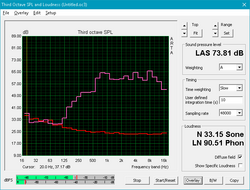
The Bang & Olufsen branded speakers are sadly mediocre. Volume is limited and comes across as thin and weak. The addition of a subwoofer (like the one used in MSI's GT75VR Titan Pro) would work wonders for the sound profile. As it stands, the overall sound is weak. Users should opt for external speakers or headphones.
HP Omen X 17-ap0xx audio analysis
(-) | not very loud speakers (65.7 dB)
Bass 100 - 315 Hz
(-) | nearly no bass - on average 18.1% lower than median
(±) | linearity of bass is average (9.9% delta to prev. frequency)
Mids 400 - 2000 Hz
(+) | balanced mids - only 3.4% away from median
(+) | mids are linear (6.3% delta to prev. frequency)
Highs 2 - 16 kHz
(+) | balanced highs - only 2.3% away from median
(±) | linearity of highs is average (9.8% delta to prev. frequency)
Overall 100 - 16.000 Hz
(±) | linearity of overall sound is average (22.3% difference to median)
Compared to same class
» 79% of all tested devices in this class were better, 6% similar, 15% worse
» The best had a delta of 6%, average was 18%, worst was 132%
Compared to all devices tested
» 64% of all tested devices were better, 6% similar, 30% worse
» The best had a delta of 4%, average was 24%, worst was 134%
MSI GT75VR 7RF-012 Titan Pro audio analysis
(+) | speakers can play relatively loud (98 dB)
Bass 100 - 315 Hz
(±) | reduced bass - on average 8.7% lower than median
(+) | bass is linear (4.9% delta to prev. frequency)
Mids 400 - 2000 Hz
(+) | balanced mids - only 3.6% away from median
(+) | mids are linear (4% delta to prev. frequency)
Highs 2 - 16 kHz
(±) | higher highs - on average 6% higher than median
(+) | highs are linear (3.4% delta to prev. frequency)
Overall 100 - 16.000 Hz
(+) | overall sound is linear (13.4% difference to median)
Compared to same class
» 19% of all tested devices in this class were better, 7% similar, 74% worse
» The best had a delta of 6%, average was 18%, worst was 132%
Compared to all devices tested
» 13% of all tested devices were better, 4% similar, 83% worse
» The best had a delta of 4%, average was 24%, worst was 134%
Frequency Comparison (Checkbox selectable!)
Graph 1: Pink Noise 100% Vol.; Graph 2: Audio off
Energy Management
Power Consumption
The Omen X 17 is about as power-hungry as other large form factor gaming notebooks. Interestingly, power draw was rather inconsistent during our load test. While average power draw sits at 199 Watts, this should be taken with a grain of salt; wattage pulled from the wall hit between 150 and 250 Watts without any regular pattern. While gaming, we do see a steadier trend to power use. Average power draw during a gameplay session of The Witcher 3 sits at about 221.7 Watts, which is well below the 330 Watt rating of the included power supply.
Speaking of the power supply, the Omen-branded brick is very large. Its square design makes it almost the size of a small desktop computer (150 x 150 x 38 mm, or 5.9 x 5.9 x 1.5 in) and thicker than the notebook itself. This hampers the portability of the system.
| Off / Standby | |
| Idle | |
| Load |
|
Key:
min: | |
| HP Omen X 17-ap0xx i7-7820HK, GeForce GTX 1080 Mobile, Samsung PM961 MZVLW256HEHP, IPS, 1920x1080, 17.3" | Acer Predator Triton 700 i7-7700HQ, GeForce GTX 1080 Max-Q, 2x SK Hynix Canvas SC300 512GB M.2 (HFS512G39MND) (RAID 0), IPS, 1920x1080, 15.6" | Alienware 17 R4 i7-7820HK, GeForce GTX 1080 Mobile, SK Hynix PC300 NVMe 512 GB, TN LED, 2560x1440, 17.3" | Eurocom Sky X4C i7-8700K, GeForce GTX 1080 Mobile, Samsung SSD 960 Pro 1TB m.2 NVMe, IPS, 3840x2160, 15.6" | Guru Mars K i7-7700, GeForce GTX 1080 Mobile, Samsung SSD 960 Evo 500GB m.2 NVMe, IPS, 1920x1080, 17.3" | MSI GT75VR 7RF-012 Titan Pro i7-7820HK, GeForce GTX 1080 Mobile, 2x Samsung SM961 MZVPW256HEGL NVMe (RAID 0), TN LED, 1920x1080, 17.3" | Razer Blade Pro 2017 i7-7820HK, GeForce GTX 1080 Mobile, 2x Samsung SSD PM951 MZVLV256HCHP (RAID 0), IGZO, 3840x2160, 17.3" | Aorus X9 i7-7820HK, GeForce GTX 1070 SLI (Laptop), Samsung SM961 MZVKW512HMJP m.2 PCI-e, TN, 2560x1440, 17.3" | Asus Zephyrus GX501VS i7-7700HQ, GeForce GTX 1070 Max-Q, Samsung SM961 MZVPW256HEGL, IPS, 1920x1080, 15.6" | |
|---|---|---|---|---|---|---|---|---|---|
| Power Consumption | -15% | -34% | -23% | -41% | -48% | -30% | -45% | 21% | |
| Idle Minimum * (Watt) | 21.6 | 28 -30% | 37.5 -74% | 30.2 -40% | 31 -44% | 34 -57% | 31 -44% | 29 -34% | 19.1 12% |
| Idle Average * (Watt) | 26.4 | 33 -25% | 37.6 -42% | 34.7 -31% | 37 -40% | 41 -55% | 36 -36% | 35 -33% | 20.8 21% |
| Idle Maximum * (Watt) | 26.6 | 41 -54% | 37.6 -41% | 37.8 -42% | 44 -65% | 50 -88% | 44 -65% | 42 -58% | 21.8 18% |
| Load Average * (Watt) | 95.6 | 94 2% | 122.4 -28% | 130.3 -36% | 116 -21% | 106 -11% | 107 -12% | 140 -46% | 73.7 23% |
| Witcher 3 ultra * (Watt) | 221.7 | 160 28% | 180.3 19% | 172.2 22% | 259 -17% | 257 -16% | 212 4% | 295 -33% | 130.2 41% |
| Load Maximum * (Watt) | 199.6 | 222 -11% | 277.4 -39% | 217.7 -9% | 312 -56% | 320 -60% | 258 -29% | 334 -67% | 173.1 13% |
* ... smaller is better
Battery Life
The 99 Wh battery does a respectable job of powering the device for normal use. While most large gaming notebooks have similarly large batteries, the Omen X 17's leaves them in the dust. Even without the benefit of Nvidia's Optimus, the Omen X 17 lasted five and a half hours in our WiFi test (Balanced profile, screen set to 150 nits, opening a new webpage every 30-40 seconds). Every competitor in our roundup shut down after 2-3 hours. While the Omen X 17 isn't designed to be a "take anywhere" device, users can still get some work done when an outlet isn't available.
| HP Omen X 17-ap0xx i7-7820HK, GeForce GTX 1080 Mobile, 99 Wh | Acer Predator Triton 700 i7-7700HQ, GeForce GTX 1080 Max-Q, 54 Wh | Alienware 17 R4 i7-7820HK, GeForce GTX 1080 Mobile, 99 Wh | Eurocom Sky X4C i7-8700K, GeForce GTX 1080 Mobile, 82 Wh | Guru Mars K i7-7700, GeForce GTX 1080 Mobile, 82 Wh | MSI GT75VR 7RF-012 Titan Pro i7-7820HK, GeForce GTX 1080 Mobile, 75 Wh | Razer Blade Pro 2017 i7-7820HK, GeForce GTX 1080 Mobile, 99 Wh | Aorus X9 i7-7820HK, GeForce GTX 1070 SLI (Laptop), 94.24 Wh | Asus Zephyrus GX501VS i7-7700HQ, GeForce GTX 1070 Max-Q, 50 Wh | |
|---|---|---|---|---|---|---|---|---|---|
| Battery runtime | -51% | -36% | -44% | -27% | -50% | -33% | -50% | -50% | |
| Reader / Idle (h) | 5.8 | 2.5 -57% | 4.6 -21% | 3 -48% | 3.3 -43% | 3 -48% | 4.2 -28% | 2.9 -50% | 3.8 -34% |
| WiFi v1.3 (h) | 5.6 | 2.4 -57% | 3 -46% | 2.6 -54% | 2.4 -57% | 3.3 -41% | 2.2 -61% | 2.5 -55% | |
| Load (h) | 2 | 1.2 -40% | 1.2 -40% | 1.4 -30% | 1.8 -10% | 1.1 -45% | 1.4 -30% | 1.2 -40% | 0.8 -60% |
Pros
Cons
Verdict
HP hit the mark with the Omen X 17. The Omen brand has vaulted from near-obscurity to a major gaming contender in a few short years, and the X 17 is the pinnacle of the line so far. There are several things that the Omen X 17 does right, but there are also a few that fall short of the target.
The mechanical keyboard is excellent and one of the better implementations we've seen in a notebook thus far. Key travel and resistance are very well-tuned, and while veteran laptop typists may need some time to acclimate to the beveled key shape, many will find the keyboard to their liking. The RGB lighting modes are fun to play with and add a nice touch to the otherwise colorless chassis. That chassis is solid, rigid, and feels like a premium tank that will stand the test of time. The 99 Wh battery has some serious endurance considering the competition. Whereas most gaming notebooks are lucky to last 2 hours, the 5+ hour runtimes of the Omen X allow for users to get some work done on the road (when necessary).
The 120 Hz G-Sync display is a major plus. Coupled with the powerful internals, the display allows for silky smooth gameplay. Competitive gamers and enthusiasts alike will find that the 120 Hz refresh rate raises their gaming experience to the next level, so much so that going back to a standard 60 Hz panel may be difficult. The excellent cooling system also keeps the main body of the laptop perfectly comfortable during those long play sessions.
Unfortunately, the Omen X suffers from the same maladies as other high-end gaming notebooks. The device is massive, and its power supply is almost comically large. This makes the Omen X 17 more of a "desktop replacement" than a laptop; the Omen X 17 is a machine that will likely spend more of its life on a desk than on the road. The overclockable CPU is a nice option, but overclocking is limited by the poor thermal performance of the CPU die when under load. There's little point to spending extra money on an overclockable CPU if it can't be overclocked, but remember that not all CPUs are binned equally. Other users may have more luck.
All said, the HP Omen X 17 is a kind of "Jack of all trades" gaming notebook that checks almost all the boxes at this end of the market. Gaming performance isn't the best in class but should be good enough. Throw in the high refresh rate display, the well-built chassis that remains cool under pressure, and the excellent keyboard, and the Omen X 17 should be considered one of the most complete packages on the market today.
HP Omen X 17-ap0xx
- 02/12/2018 v6 (old)
Sam Medley




